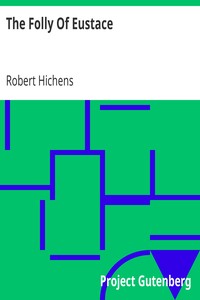The Folly Of Eustace by Robert Hichens
"The Folly Of Eustace" by Robert Hichens is a novel written in the late 19th century that explores themes of identity, societal expectations, and the contrast between appearance and reality. The story primarily revolves around the protagonist, Eustace Lane, a young man with a penchant for eccentricity and a desire to cultivate a distinct persona in the society he inhabits. As he navigates his relationships and the expectations placed upon him, he
grapples with the consequences of his choice to present himself as a buffoon to gain notoriety and attention. The narrative follows Eustace from his formative years at Eton through his rise to prominence in London society, where he is both celebrated and scrutinized for his whimsical behavior. Eustace's journey is marked by his internal struggle between the façade he has created and his true self, particularly highlighted by his love for Winifred Ames. As their relationship evolves, the cracks in his fabricated identity begin to show, leading to a poignant exploration of authenticity, connection, and the personal toll of maintaining an invented persona. Ultimately, the story concludes with Eustace confronting the emptiness of his pursuit for fame, as his marriage begins to suffer under the weight of his unresolved conflicts and pretenses. (This is an automatically generated summary.)
Read now or download (free!)
| Choose how to read this book | Url | Size | ||||
|---|---|---|---|---|---|---|
| Read online (web) | https://www.gutenberg.org/ebooks/23420.html.images | 91 kB | ||||
| EPUB3 (E-readers incl. Send-to-Kindle) | https://www.gutenberg.org/ebooks/23420.epub3.images | 98 kB | ||||
| EPUB (no images, older E-readers) | https://www.gutenberg.org/ebooks/23420.epub.noimages | 99 kB | ||||
| Kindle | https://www.gutenberg.org/ebooks/23420.kf8.images | 182 kB | ||||
| older Kindles | https://www.gutenberg.org/ebooks/23420.kindle.images | 173 kB | ||||
| Plain Text UTF-8 | https://www.gutenberg.org/ebooks/23420.txt.utf-8 | 76 kB | ||||
| Download HTML (zip) | https://www.gutenberg.org/cache/epub/23420/pg23420-h.zip | 95 kB | ||||
| There may be more files related to this item. | ||||||
About this eBook
| Author | Hichens, Robert, 1864-1950 |
|---|---|
| Title |
The Folly Of Eustace 1896 |
| Note | Reading ease score: 82.3 (6th grade). Easy to read. |
| Credits | Produced by David Widger |
| Language | English |
| LoC Class | PR: Language and Literatures: English literature |
| Subject | Fiction |
| Category | Text |
| EBook-No. | 23420 |
| Release Date | Nov 8, 2007 |
| Most Recently Updated | Jan 26, 2021 |
| Copyright Status | Public domain in the USA. |
| Downloads | 127 downloads in the last 30 days. |
| Project Gutenberg eBooks are always free! | |

